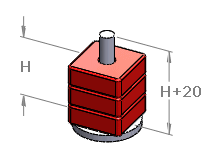If a part contains external references from a
multiconfiguration
assembly, best practice is to have a corresponding part configuration for each assembly
configuration.
With
a multiple-to-one (n:1)
relationship,
only the most recently updated assembly configuration
is
up to date. The other assembly configurations
are
out-of-date,
and
can
take time to rebuild when you activate them. Also, the different versions of the part's
single configuration do not have unique identifiers, which could result in the wrong
version being manufactured or purchased.
Best practice is to have a one-to-one (1:1) relationship between
configurations of the assembly and the configurations of the part.
Example
An assembly named
Stack
has a stack of blocks on a part named
Fixture. You want the height of
Fixture to be 20mm higher than the stack of blocks. That is, if
the height of the stack of blocks is H, then the height of
Fixture is
H+20.

The assembly has three configurations. Each configuration has
different sized blocks, and therefore different values for H. The fixture is created
in the context of the assembly, and its height is defined as being offset 20mm from
the face of the top block.
Problem:
n:1
Relationship - Not Recommended
| Assembly Configuration |
Height (H) |
Part Configuration |
Height (H+20) |
| Small |
30 |
Default |
50? 65? 80? Depends on which assembly
configuration is active.
|
| Medium |
45 |
| Large |
60 |
Up-to-date configuration data is saved only for the most recently updated
assembly configuration, because the height of
Fixture is out of date for the other two configurations. For
example, if you activate assembly configuration
Large, then the height of
Fixture is 80. Therefore, for configurations
Small and
Medium, the height of
Fixture is out of date.
Solution:
1:1 Relationship - Best Practice
| Assembly Configuration |
Height (H) |
Part Configuration |
Height (H+20) |
| Small |
30 |
Short |
50 |
| Medium |
45 |
Average |
65 |
| Large |
60 |
Tall |
80 |
Now each version of
Fixture
has a unique identifier. Up-to-date configuration data is saved for each assembly
configuration. Time to switch between assembly configurations improves because the
data does not need to be rebuilt.